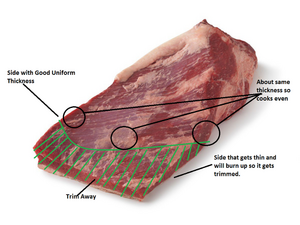Hi there and welcome!
I'm sorry to hear that it didnt turn out so well.
If you have a tough but cooked and edible brisket or piece of brisket then chopping it up and putting with some bbq sauce and putting in a plastic bag in the fridge for a couple of days usually does the trick. You just warm it back up in a skillet or a crockpot and it should be tender and good to go.
If the meat is crusted and dried then not much can be done with that, it is basically burnt up.
I also noticed you were mentioning cooking by time. With briskets and pork butts you never cook by time to tell you when it is done. The only thing that lets you know when it is done is Tenderness.
We all use bbq thermometers that allow us to put 1 or more meat temp probes deep into the center thick parts of the meat. With a brisket you want to get to the center most yet thickest part of the Flat muscle with the temp probe. When it reaches about 199F degrees of internal temp (IT) you check for tenderness to see if it is done. I use long wooden bbq skewers to do this, they are cheap and u have a bunch in a pack to grill kabobs with so their very useful.
When the skewer goes in ALL OVER with no resistance than the brisket is Tender and therefore ready. If it is giving some resistance in parts then wait a couple of degrees and check again. Repeat this process until it passes the Tenderness test.
If you go by time or temp alone you can under cook a brisket (tough and dry) or you can overcook a brisket (dry and falls apart) or you can WAY overcook a brisket (crusty and burnt up breakable texture).
Also I always recommend that people trim the flat like the following to remove the thin portion that WILL burn up on you because it is so much thinner than the rest of the hunk of meat. So remove that meat and use it for something else or simply added in later or pull that chunk of meat earlier when it is done. Here is the trimming image I mention:
Here is a thread detailing the trimming approach and what u can do with that good meat:
Well I have had a number of private messages where people ask for more info about what I do when I trim away the thin Flat portion of a brisket I smoke. So today I figured I would just post about it with plenty of pics so it becomes easier to understand vs when I just go "blah blah blah trim...

www.smokingmeatforums.com
Finally, when learning to cook a brisket or any cut of meat I always suggest going simple and planning well.
I would like to suggest that you use a simple seasoning. Trim the brisket as mentioned above and smoke the brisket whole. Put the probe where I mentioned and pull when it passes the tenderness test. A smoker at constant 275F will go a little over 1 hour a pound or so until you find it passes the Tenderness test, sometimes shorter, sometimes longer... Tenderness checking is the key! Plan to finish the brisket cook 4 hours before time to eat because you will likely need that extra time should the brisket go over. If the brisket finishes 4 hours early then tightly double wrap it in foil, wrap in 3 bath towels and set it on the counter and 4 hours later it will be piping hot so no time lost and you had 4 hours of great brisket resting.
DO NOT open, spritz, wrap, massage, fondle, dance with, chant at, or mess with the meat in any fashion until the thermometer tells you to check for tenderness... again this is keeping things simple.
Once you get a successful couple briskets done like this you can add 1 or 2 minor tweaks with each brisket you smoke to get your setup, process, and taste profile down to what you like and understand how the change improved/detracted away from the last attempt.
Again go simple and take simple steps and changes and you will have success.
I've thrown a tun of brisket info at you so I'll stop here but do not hesitate to ask any questions. This is a great community and we will help you make a brisket you can be proud of! :)








